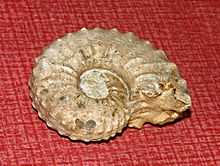| Acanthoceras | |
|---|---|
 | |
| Fossil of A. rhotomagensis from France, on display at Galerie de paléontologie et d'anatomie comparée in Paris | |
| Scientific classification | |
| Domain: | Eukaryota |
| Kingdom: | Animalia |
| Phylum: | Mollusca |
| Class: | Cephalopoda |
| Subclass: | † Ammonoidea |
| Order: | † Ammonitida |
| Family: | † Acanthoceratidae |
| Subfamily: | † Acanthoceratinae |
| Genus: | † Acanthoceras Neumayr, 1875 |
| Species | |
See text | |
Acanthoceras is an extinct cephalopod genus belonging to the subclass Ammonoidea and family Acanthoceratidae that lived from the Albian to early Coniacian stages of the Cretaceous. [1]